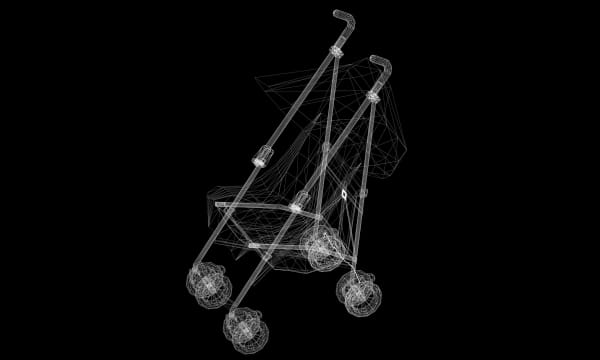The anatomy of a stroller

What's a stroller? Every person that at least looked at child transportation knows that a "stroller" means a lot of things. Here's a summary of what it is, what it can be, and what parts and uses you can expect from a stroller (pram, pushchair, buggy).
A stroller always consists of a chassis (three-wheeled, four-wheeled, more-wheeled in case of double, triple, quadruple strollers) with wheels (different types of wheels are used), and the attached part for the child to ride in. The click-on part could be a carrycot (also called a bassinet), creating a pram, a seat unit that can be reversible or fixed (most usually in the forward-facing position), creating a pushchair (or a buggy if small/compact), or a 0+ car seat (often attachable with car seat adapters - and these differ depending on the car seat brand), creating a travel system. A possibility of combination of the two or all three elements, or a complete, pre-made stroller set, is also called a stroller system.
Wheel number-wise, most differences are between a three-wheeled stroller - also called a jogger since it was primarily designed for sports and jogging use, and a more traditional four-wheeled stroller.
Wheels
A four-wheeler, even if it varies from model to model, is usually very well off in terms of stability; its look feels symmetrical and, most of the time, it's a more stylish option.
A three-wheeler features a longer and/or wider (in the back) chassis (since the stroller's stability increases with a longer and/or wider frame), "sharper" sporty lines, and, often, a decelerating handbrake on the handlebar, as well as - usually - larger wheels.
There are also different wheel/tire types to be considering. The basic difference is between air-filled wheels and solid - no-maintenance wheels.
The maintenance-free wheels can still be divided into categories with very different suitability of use: basic plastic or EVA foam wheels, rubberized or rubber-covered wheels, and then wheels with tires filled either with foam or with gel, trying to emulate inflatable wheels but without the need of inflating or the risk of a puncture. A lot depends on the wheel size and the associated stroller suspension system as well. Find out more about stroller wheels and different wheel types in this article.
Suspension
An important feature adding to the comfort, as well as all-terrain ability, is its suspension. Stroller suspension is a set of extra mechanisms built into the chassis, adding the shock-absorption and/or even a rocking ability, but also weight and bulkiness to the stroller.
Modern-day strollers' chassis are usually less soft, suspension-wise, focusing on the low weight and foldability (instead of the rocking comfort of the old perambulators).
One can look at suspension from different points of view, acknowledging different types.
One of the views is from the point of the chassis, distinguishing between 2 types of suspension systems:
the rocking suspension usually found on C- or X-shaped retro-style frames (or the more modern adjustable spring-suspension systems on the rear wheels, often found on Polish-made stroller systems),
the shock-absorbing, stiffer-felt suspension systems found on modern, lightweight strollers.
Another way of looking at suspension would be from the point of the wheels, recognizing central, front, rear, or all-wheel suspension systems of different levels of softness.
Handlebar
The frame will always have a handlebar that can be fixed in one single position or adjustable.
There are two ways of adjusting the height of a handle - by rotating it, which helps the center of gravity but doesn't change the distance of the end of the handle from the base of the chassis, or by telescoping it in or out to fit the step better but not always help the center of gravity. Problems-concerned, a rotating handle can easier break with strain, and the telescopic handle can be loose or even rattle.
An adjustable handlebar is a practical feature to have on a stroller but is not always necessary - and as a moving part, it always weakens the chassis slightly.
Basket
Most strollers have a storage space in the form of a "shopping" basket in the bottom part. It can be open for easier access and more space, or closable for more privacy (which, however, also diminishes the space inside). Some baskets can also be opened and enlarged.
There are also special designs that make the basket a solid, removable accessory to also carry in hand or designs in the form of a handbag.
Folding
Even if not so in the past, nowadays' strollers can almost always be folded. There are different types and sizes of folding, but the general rule is - the simpler, the sturdier, longevity-wise, and also, the more all-terrain the stroller, the bulkier the folded size.
The fold can be one-handed or needing two hands, with the seat attached in one or both directions, or a two-piece fold, meaning one has to remove the seat unit before folding the frame.
After the fold, the folded stroller can be simply put down, or it can free-stand (a "standing fold"). There is (often, but not always) a plastic lock or an internal locking mechanism that will hold the folded package together, so it doesn't open while being carried or loaded in the car. Sometimes one has to lock the folded stroller manually (e.g., with a strap or a movable plastic hook), or there's no lock at all.
Seat unit
A reversible seat is a feature often present in stroller systems, and it is best for small children moving from a from-birth carrycot. It can be more of a burden later on since it always makes the stroller heavier & bulkier while less spacious for an older child when compared to a world-facing pushchair.
The changing need of the baby, as well as more mobility with a toddler, are also why many parents end up using at least two different strollers/stroller types with one child.
A forward-facing seat cannot parent-face, making a stroller simpler but also roomier and (in general) lighter. The world-facing seat is attached directly to the frame, so it is a wider seat (and often a less upright seat, even though, not always), better for a toddler. Because of many having a lie-flat option, they are stated as newborn-friendly - it is, however, not the most optimal setup for a small, fragile newborn baby that usually a parent wants to watch more closely.
Seat units can also be differentiated to a "traditional" seat with an individually adjustable backrest and leg rest, resulting (often) in a lie-flat position, and to an ergonomic - shaped seat bucket-type seat unit (this is almost always reversible) that is reclined as a whole, by tilting the whole unit preserving its L (or V) shape.
Carrycot
A carrycot (or a bassinet) is an attachable stroller system part that is the best solution for a newborn baby because of it being made as a lie-flat, sturdy, protective environment. It is not a necessity, but a carrycot is a better option if parents can afford it financially or space-wise.
A solid-base - rigid, semi-rigid (foldable), or a soft (insert) carrycot can be used. Also, 2in1 convertible carrycot-to-seat type is also available in some stroller systems - if used in the lay flat, it is an acceptable budget-friendly option good for the first year of two of the child (the seat of these is usually on the smaller side, room-wise).
For more carrycot information, consult Strollbery's detailed carrycot-choosing guide.
Car seat (travel system)
A 0+ car seat (or a capsule) can be attached to most stroller frame either with a set of adapters or without adapters thanks to a system allowing it to be attached right on the chassis or on some part of the stroller (e.g., on the bumper bar or on the seat, secured with a strap). A stroller with a car seat creates a "travel system" that is easy to load in the car, car seat being used, and the boot only needing to fit the frame of the stroller.
It is important to choose a well-made, tested car seat because it is the only protection given to a fragile child while traveling by car. Also, the cheaper car seats can be very small, space-wise, so they won't last long, and they also don't provide much support for the baby in it, putting a huge strain on its neck and spine.
Stroller system
A stroller system is a multifunctional system of the frame compatible (and usually offered) in combination with a carrycot (a 2in1 stroller system) or a carrycot and a car seat (a 3in1 stroller/travel system). There can even be more parts offered (a stand, a summer seat, etc.), creating a more-in-one system.
A stroller system is often the first go-to for first-time parents thinking it will solve all their needs in one purchase.
It is not always the case - mainly, the more affordable stroller systems can have important downsides and weaker seat unit/car seat designs. Most people also end up owning at least two strollers - a full-size system and a lightweight, compact forward-facing pushchair/buggy for later.
Double strollers
To use a stroller for two children, different designs are available. The most common are the side-by-side design and the tandem - one behind the other - design. There are also single strollers that can be converted into doubles by adding a second seat - often with adapters or sibling kits. The single-to-double strollers are usually tandems, with a few exceptions.
One can also use a sibling board (some have even the possibility of an attachable seat) attached behind a single stroller to accommodate an older toddler (this will take most of the parent's room for walking). Another way to double a single stroller is a Buggypod-kind of added side seat.
For more about double strollers, check out this article.
